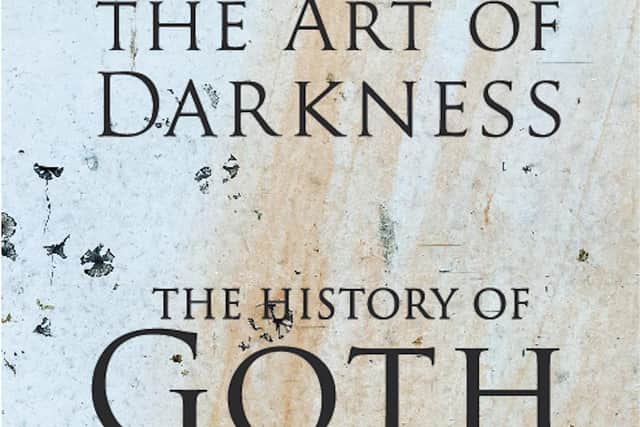John Robb: 'Leeds was a driving force in Goth'


At more than 600 pages long, his book The Art of Darkness is the product of ten years of research and an attempt to put Goth’s musical flowering at the turn of the 80s into a broader historical context, as Jon Savage did for punk in his much-praised tome England’s Dreaming.
“Because there’s so many rabbit holes it’s the kind of book that would take ten years to write, I hate missing stuff out of things,” says the 61-year-old frontman of Blackpool post-punk band Membranes, who back in the 80s wrote for the music magazines ZigZag, Sounds and Melody Maker and went on to found the pop culture blog Louder Than War.
Advertisement
Hide AdAdvertisement
Hide Ad“The other thing was it wasn’t just a list, everything had to be tied together. Even a really obscure Romantic poet had to be in there because it’s part of the narrative. I loved the idea of the Romantic poets of the early 19th century being the rock stars of their time. Also the ones that are obscure are like the underground Goth bands whose stuff didn’t quite hit the mainstream.”
A key theme, he says, is that “every generation is dealing with its blues with whatever they had at the time – in the 19th century it would have been with a quill, while in the late 70s and early 80s it would’ve been electric rock ’n’ roll because that was right in the middle of our culture when we were all growing up, whereas now it's more about Instagram and TikTok and YouTube”.
Robb’s book starts with the Visigoths’ sacking of Rome in the 4th century AD and covers everything from folklore to philosophy, literature and the occult – all of which would eventually feed into alternative music created by the likes of Bauhaus, The Cure, Siouxsie and the Banshees and the Sisters of Mercy via influences such as The Doors, The Stooges, the Velvet Underground and David Bowie. He notes that none of them would actually regard themselves as Goths.
“When all those bands started there was no such thing as Goth, it was a retrospective name given to a scene that was already there,” he says. “Really when you look back at it, it was just a darker version of post-punk...Like other scenes such as punk, it was never codified when it started.”
Advertisement
Hide AdAdvertisement
Hide AdIf the Batcave nightclub in Soho was the heart of the London scene, Leeds was very much its epicentre in the north. Leading the way were the Sisters of Mercy, with others such as The March Violets, Skeletal Family, Red Lorry Yellow Lorry, Salvation, Ghost Dance and The Mission following in their stead. Robb says the Sisters’ frontman Andrew Eldritch preferred the term “M62 music” to describe his own band. “He felt they had more in common with (Echo and) the Bunnymen, the Teardrop (Explodes), Joy Division, going along the M62, with a detour to Sheffield for The Human League...It felt like a completely different scene, so I was trying to untangle that part (in the book) as well.”


The scene’s favourite haunt in Leeds was Le Phonographique – or the Phono – where Claire Shearsby, who would become Eldritch’s partner, DJ-ed. “Let’s give Leeds its due, it was a driving force in this,” says Robb. “It was down to Andrew Eldritch and Claire Shearsby, his girlfriend at the time, who was the one who was playing all these rock records. She was playing the Ramones and Motorhead when they weren’t that cool bands to like, she was like the educator, in a sense, and was really key. Everyone has mentioned her in the story, how important she was. (Eldritch) would step in when she couldn’t DJ. He wrote Floorshow, which is a really dark song, at the Phono.
“It was like different schools, Southern Goth and Northern Goth, but in a way every city reacted differently to post-punk. Liverpool had the Bunnymen, who latched onto The Doors and West Coast psychedelia, in Manchester it was Joy Division which was futuristic and Bowie-eseque, and in Leeds it was the Sisters with the rock thing, when everyone else was down on rock Leeds embraced it. That’s so Yorkshire, isn’t it? If everyone else was down on rock, there it was ‘don’t tell us what to like’.”
Robb believes Goth flourished in provincial towns and cities because it wasn’t about being fashionable. “It was kind of an open space,” he says. “What was that great saying – they gave us the keys to the playground and we just went in there. When you’re young you need that permission to do stuff. You’ve never thought wow, I could do that – especially if you grew up in a place like Blackpool, like me. There’s no precedent for it.
Advertisement
Hide AdAdvertisement
Hide Ad“That’s what’s interesting when you think about bands like Southern Death Cult who came out of Bradford, and New Model Army, they’re another band who changed the city, in a sense. Justin (Sullivan) must be the first student who moved to Bradford who actually stayed there. In Manchester, every student stays, never leaves, that’s why there’s 30,000 people trying to get a flat in the city centre. Whereas Bradford, which I love as a city but it’s a bit difficult because it’s been so knackered by government policy forever. But Justin stayed there and people could live in his house, and Joolz was a driver. Steven Wells used to sleep on the settee and they had a rehearsal room downstairs which is where Southern Death Cult formed. Those kind of people create space for things to happen.
“I really like Aky (Qureshi)’s story from Southern Death Cult as well. He was an Anglo-Pakistani punk whose dad just didn’t get it, but in a really cool way. He says at the end of the interview (in The Art of Darkness) that he respects his dad for being straightlaced; there were certain aspects to that that he likes as well. He was putting gigs on, when he put Crass on in Bradford, that was the gig that Ian Astbury came to.”
It brings Robb back to the Romantic movement. “It’s all those things like Lord Byron and Mary Shelley and John Polidori, all those people in that weekend by the lake (Geneva) trying to write ghost stories,” he says. “It’s the same thing that was going on in Justin and Joolz’s cellar in Bradford or a couple of streets in Leeds where Andrew Eldritch and Jon Langford lived. Everyone was in a band and everyone was borrowing the same drum machine and the same drum kit. (Simon Denbigh of) The March Violets was the one who looked after the drum machine and took it for a little walk like a dog, and Jon Langford’s drum kit is on the first Sisters’ record.
“I love The Three Johns, they’re the most Goth-sounding of any of those bands but because they didn’t look like Goths nobody cottoned on. If you listened to their records they would fit into any Goth club in the world in the 80s.”
The Art of Darkness is published by Louder Than War Books, priced £25. John Robb will be talking and signing copies of the book at Jumbo Records in Leeds on Saturday April 1 at 2pm.
